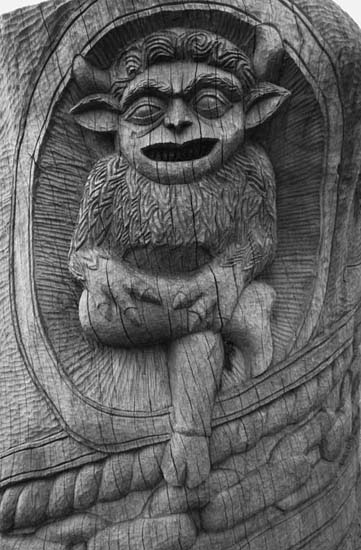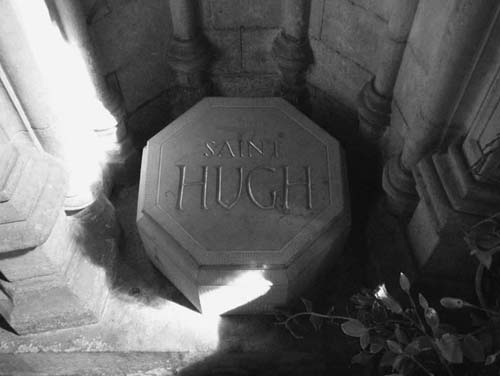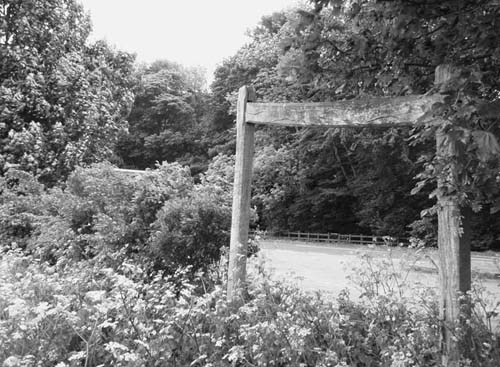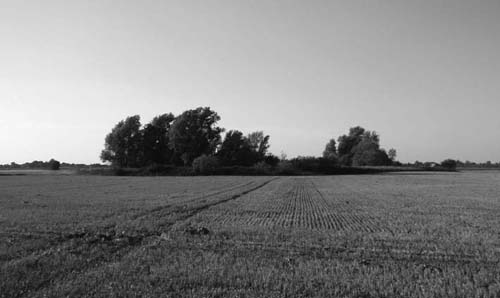Folklore of Lincolnshire (4 page)
Read Folklore of Lincolnshire Online
Authors: Susanna O'Neill

For the tiniest angel, with amethyst eyes
And hair spun like gold, ‘fore the alter did rise,
Pronouncing these words in a dignified tone
‘O impious Imp, be ye turned to stone!’
The petrified imp has become something of an attraction now, with tourists clamouring to get a glimpse of his cross-legged pose and wicked grin, peering down from his high place in the Angel Choir at the east end of the cathedral.
The Devil must have been a regular visitor to the cathedral, as there is a legend connected to the tomb of St Hugh. The belief was that when you closed your eyes to pray, you were in danger of the Devil coming up behind you, unseen, and so when you knelt to pray at St Hugh’s shrine there was a shallow dip containing salt which you could take and throw over your left shoulder to blind his approach! This may have been the origin of the superstition that if one spills some salt accidentally, a pinch of it should be thrown over the left shoulder to blind the Devil.
Also, outside near the Chapter House there once stood a well and the myth ran that on Halloween, if you circled around it three times anticlockwise and then peered into its depths through holes in the walls, you would see the Devil.

A close-up carving depicting the Lincoln Imp. Found in the top Humber Bridge car park area, on the Hull side.
Another popular visitation from the Devil appears in the form of wind. The
Lincolnshire Life
magazine explains that the residents of Boston have a special name for the footpath which runs between the river and the tower of Boston Stump.
8
They call it ‘Windy Corner’ and it seems that in this particular spot there is a constant wind. Even on a calm day there is a ‘stiff breeze which seems to blow from all directions at once’. The legend states that St Botolph, to whom the church is dedicated, had an encounter with Old Nick here. They were engaged in an epic battle
but Botolph came out victorious, giving the Devil such a beating that he is there, panting from exhaustion, or anger, to this very day.

St Hugh’s shrine is situated at the east end of the Angel Choir of Lincoln Cathedral, to the north side of the area below the great east window. A shallow depression a little to the left and behind the shrine is where the salt could have been kept.
They say that the buffeting gusts of wind that howl round the south-west side of Lincoln Cathedral are remnants of the great wind that threw back the Devil! This is an alternative version to the Lincoln Imp story – the Devil with a horde of demons came to cause havoc to the beautiful building in 1092. They swirled round the cathedral, intending to lay waste to it but the bishop, Remigius, prayed to the Virgin Mary for aid in defeating these foul beasts. His prayer was answered by a tremendous gust of wind, and the strength of it blew back the devilish crowd, defeating the Old ‘Un and his cronies. However, legend tells that one imp was actually blown inside the cathedral but the stone angels protected their domain by petrifying the imp – hence the stone figure we see today.
These stories and the figure of the imp are so well known that today Lincoln City football team are nicknamed The Imps and the little Devil appears on their crest!
Adrian Grey has a variation on why this corner of the cathedral is so windy.
9
He says it was in the days when Lincoln fell into bad ways, with drunks and adulterers roaming the city. The Dean was apparently no better and was actually on good terms with the Devil. One day the Devil was visiting Lincolnshire with his friend, the wind, causing a bit of a stir and blowing up trouble, when he looked upon
Lincoln and decided to pop in and see the Dean. They made their way to the cathedral but the Devil told the wind to wait outside for him. The wind waited and waited, blustering around but the Devil never returned and so the wind waits there still.
The
Lincolnshire Life
magazine tells us of an incident when an angel disrupted another of the Devil’s plans.
10
A rich squire named Simon Greenleaf, who owned Nut Hall, Quadring, refused to give alms to the village church, as expected from a man of his standing. His loyalties lay elsewhere and it is said he practised black magic in the tower of his residence. The local priest was irritating him and they had had a few arguments, one of which left Greenleaf with the desire for revenge. Using his black magic he brewed up a potion ‘which would destroy the souls of the infants which it touched’. He broke into the church and swapped the font water for his devilish creation, knowing there was to be a christening the next day. Little did he realise, however, that he was being observed – an angel appeared and commanded him to leave. In his irreverence, he taunted and laughed at the angel who then took up the font and poured the evil mixture all over Greenleaf. He ran from the church screaming and when people came to see what was going on, they found him stone dead in the graveyard.
The Devil is often blamed for people’s misdemeanours, unfortunate events or bad luck. One old belief in Lincolnshire was that every Michaelmas night the Devil would travel around and spit on all the blackberries, and so after this date they were not fit to be eaten. Michaelmas occurs on 29 September, which is naturally towards the end of the blackberry season – a convenient tale to explain their decay. Gutch and Peacock add that when Satan was thrown out of heaven he fell into a bramble bush and was sorely annoyed!
11
Thus every year he spoils the very bushes that remind him of his fall and the berries become ‘as hard as the Devil’s forehead’.
Rudkin quotes a Mr Sibsey, who tells of another old belief that helps to explain the supposed power Old Nick has over crops:
In the neighbourhood of Frieston, triangular corners of fields are filled with trees, and the groups were known as ‘Devil’s Holts’. The belief is still current that these were left for the Devil to play in, otherwise he would play in the fields and spoil the crops.
Polly Howat relates an interesting story of the unfortunate farmer John Leech, who got on the wrong side of the Devil.
12
The legend says Leech was rather the worse for wear in his local tavern and his friend wanted him to go home. Leech, however, wanted to stay and apparently shouted, ‘Let the Devil take him who goeth out of this house today,’ and they both carried on drinking. Eventually Leech decided to leave, as he wanted to go to the local Whittlesey Fair, near Raveley. His friend was said to remind him of the oath he swore, but the farmer just laughed and started his journey. He was so drunk, however, that he lost his way and ended up riding round in circles until nightfall. Two griffins then appeared and barred the poor man’s way
and he heard a dreadful voice remind him of the oath he had broken. Leech was terrified and fell from his horse, whereupon two imps emerged from the bushes and began to beat him. They hauled him up into the sky and flew with him for miles, eventually dropping him and disappearing. The bloodstained farmer was found the next morning and taken to a local house, where a doctor was called. The poor man seemed to have lost his mind and tried to attack the parson, who was summoned after he had narrated his tale. The frightened locals tied him to the bed and locked his door overnight. All seemed very quiet in the morning, so they unlocked the door, but were faced with a horrible sight. Leech’s neck had been broken and his body was black and swollen all over, with every bone pulled out of joint. It was then that his story was believed and all who saw his body realised the awful consequences of making drunken oaths.

What is left of the Melton Ross gallows today, in a field next to a lay-by along the A18, midway between Melton Ross and Wrawby.
Rudkin tells the tale of another man, Tommy Lindrum, who sold his soul to the Devil. As the road was usually so bad between Wroot and Lindholme, he decided one day to make a causeway between the two. The Devil pledged to help his disciple, boasting he would make it faster than a man on a horse could gallop. For some reason, however, the Devil seemed to give up helping Tommy halfway through the job. It has been speculated that Tommy had tricked him somehow and thus escaped with his soul intact. People say there is still evidence of the beginnings of a cobbled causeway there now, although it is mostly grassed over. The legend states it is bad
luck to touch the stones, and one farmer, when he tried to move them, lost all his horses in the process – they just dropped down dead!
Another well-known tale
13
is that of four boys who were playing at the site of the gallows at Melton Ross in the 1790s. With the thoughtlessness of youth they were playing at ‘hanging’, whereby each one would hang from the gallows with a noose around his neck for as long as possible, then his friends would lift him up and let him breathe again. One of the boys had just started hanging when an injured, three-legged hare was said to have limped past. This caught the attention of the other three who thought they could catch the poor thing. When they went to grab it, however, the hare suddenly ran off into the woods with the boys in hot pursuit, completely forgetting their friend. When they eventually returned after losing the hare in the undergrowth, their friend was dead. Belief was that the hare was in fact the Devil in disguise that fateful day. After all, it was surmised, the Devil is the epitome of evil and desires to destroy anything that is good and pure.
He was also said to have been seen frolicking round Church Hill at Dorrington one night as a white rabbit, before changing back into the figure of the Devil. Hares and rabbits seem to be a popular form of disguise for witches too, who are said to be the Devil’s handmaidens.

Manwar Rings, an overgrown grass-topped plateau surrounded by a deep moat, can be found across a farmer’s field over the road in a westerly direction from the old Swineshead Abbey House. Thought to be an old Danish encampment and the resting place of Hubba the Dane, it was also used in the Second World War as an ammunitions depository. Traces of this can still be found in the undergrowth.
Ghost story writer Polly Howat describes one incident where the Devil rescues a witch from an angry mob of locals intent on killing her. The witch was called Crazy Kate and apparently used to visit the Manwar Rings at Swineshead to commune
with her master. There were many unfortunate happenings in the village at that time and the locals began to suspect Kate, especially as she had three cats, which are well known witch familiars. They gave her an ultimatum, to leave town or have her house burnt down, but Kate allegedly cursed them and promised misfortune to any who tried to harm her. More misfortune befell the village and when a baby died there was uproar, even the priest blamed Kate and said more children would die if something was not done. The mob needed no further encouragement and went to Kate’s house to kill her, but she was not there. Eventually they tracked her to Manwar Rings, where she was standing on top of the bank. Just as they were closing in on her, ‘A black cloaked stranger rode up the mound on a powerful black foam-lathered horse, whose hooves thundered and echoed around the encampment.’
14
This devilish figure swept her away and she was never seen again.
